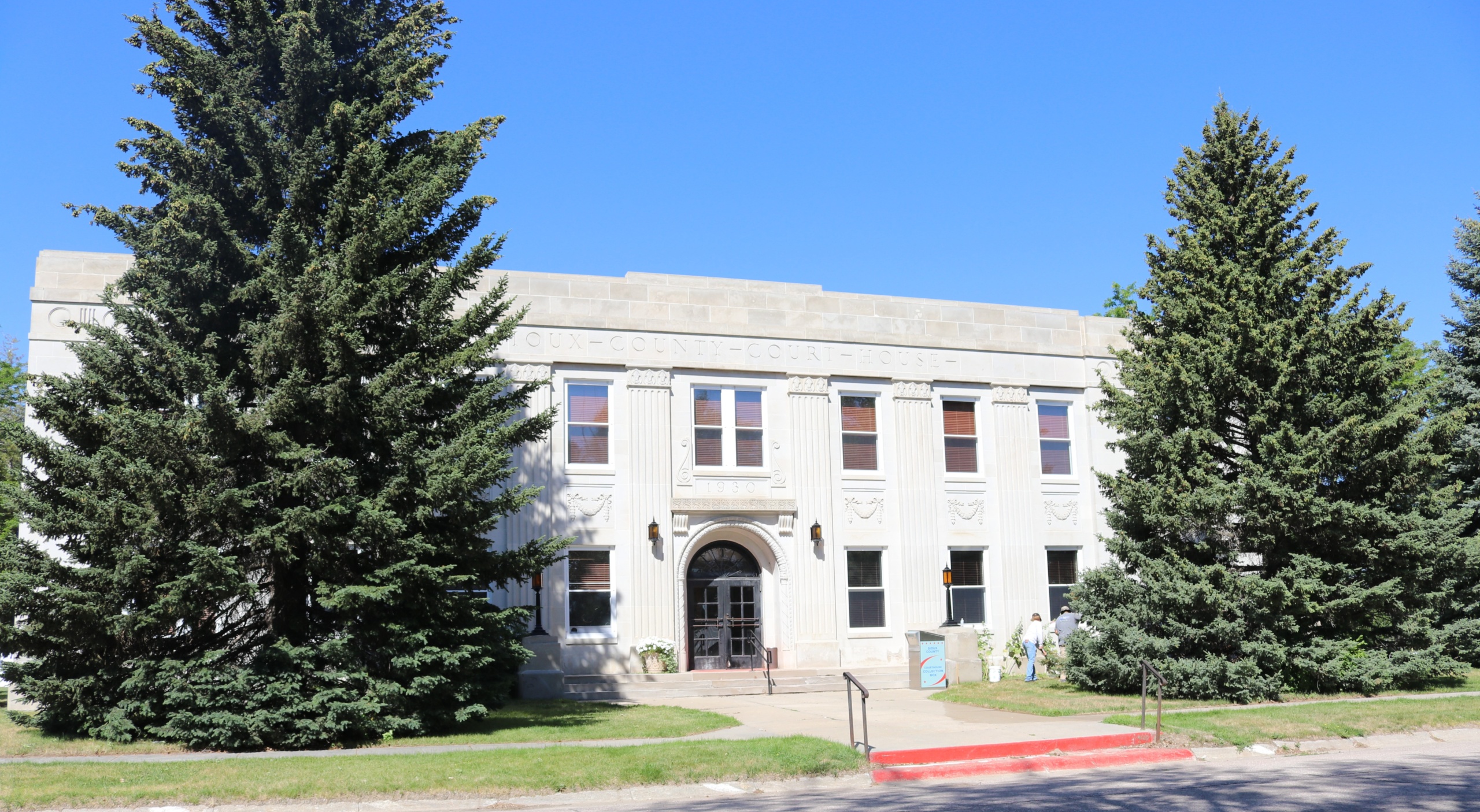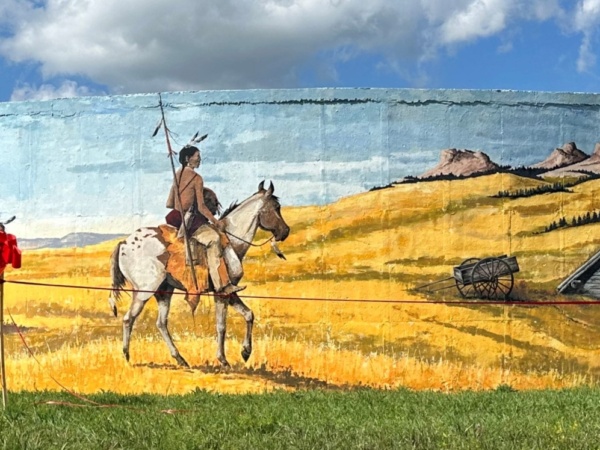
Historical courthouse functional restoration transforms windows
By Kerri Rempp
Discover Northwest Nebraska
Sioux County’s historical courthouse underwent a facelift this summer.
Listed on the National Register of Historic Places since 1990, the courthouse was in desperate need of new windows. Due to the age of the building, that’s a larger project than one might think.
“There are 86 double hung windows and 10 transom windows,” said Randal Weber of Lincoln. Weber, along with Ben Brunick of Yankton, S.D., spent the last three months living and working in Harrison to restore the courthouse windows in keeping with the historical nature of the building.
“It’s a functional restoration,” Weber explained. “The focus isn’t on we want perfect and brand new. We want to keep what we have; we want them to open and we want them to work.”
The cornerstone for the Sioux County Courthouse was laid in 1930, and staff moved in to the building in 1931. The building replaced an 1888 facility that was, according to the National Register of Historic Places application, “in a perilous state.”
“The Sioux County Courthouse is a fine unaltered example of the property type County Citadel…Identifying features include… the impression of a government building representing modernity, simplicity, strength and prosperity,” the application reads.
The building is one of just six stone-faced County Citadels constructed in the state from 1917-1930.
The courthouse windows were specifically noted in the National Register paperwork.
“Rectangular double-hung windows occur between the fluted pilasters. Slightly projecting pays with three-part rectangular windows flank the pilasters, and there are five bays with paired rectangular windows on the north and south facades of the 100’x62’ building.”
Also mentioned is the fact that the windows had been replaced at some time with a style similar to the original windows and the “art glass panel on the staircase landing.”

Weber and Brunick spent the summer stripping paint, replacing window glazing and 60 pieces of glass, replacing broken or missing ropes, restringing weights, cleaning and rehanging hardware, repairing sills, replacing weather stripping and installing new “all season storms” from Spencer Works.
Before they could even begin, they visited the site last fall and built templates of each window with pine strips. While everything looks square, it’s not, and the templates helped them create and order exactly what they needed for each specific window.
Windows that did not have storms were in the worst shape; one sill was actually in three pieces and had to be repaired.
“Your fingers would freeze in the winter,” said Sioux County Clerk Michelle Zimmerman of typing in her office during the cold season.
The county hired architect Jerry Berggren of Lincoln to design and spec the project, and he convinced Weber and Brunick to place a bid.
The pair are friends, and each summer they pick one project to work on together, either in Nebraska or South Dakota. Typically, those projects last three to five weeks.
“We’ve never done one that took three months,” Weber said. “We are pretty happy with the end result.”
Weber said nearly half of his business is millwork for historical buildings, and Brunick’s work follows the same trend.
“This kind of project isn’t for just any contractor to do,” Zimmerman said.
“You have to have somebody who nerds out a little bit on old buildings,” Weber added.
The project isn’t quite finished, as the “art glass panel” – the stained glass windows on the west wall – will wait until next year for restoration. The glass didn’t have the protection it should have, Weber said. He and Brunick installed new storm windows over the stained glass, but Weber will return and remove them next spring to deliver them to a stained-glass specialist in Lincoln to be rebuilt. Weber, meanwhile, will remake the sash and then reinstall everything.
The project equals a $500,000 improvement to the courthouse, Zimmerman said. The county is using some ARPA (Covid Relief) funds and inheritance tax to pay for the restoration.

The Sioux County Courthouse serves a 2,055 square-mile area. The county was originally established in 1877 and decreased in size as surrounding counties were formed. Its final boundaries were established in 1886, the same year Harrison was planted as a stop along the Chicago & Northwestern Railroad. At the time, the town was named Summit. The 1888 courthouse was made of locally-produced brick but it had deteriorated beyond repair by 1929, and the county hired E.L. Goldsmith of Scottsbluff to design the current building. A bond election in February of 1930 was approved and the old building was razed. The new cornerstone laid that July and the building open the next March.
A two-foot metal bull that topped the original courthouse as a nod to the region’s importance as cattle country, was salvaged and is now inside the current facility.
Goldsmith designed the courthouse with Bedford Limestone on three sides and a light tan brick on the rear and incorporated Classical Revival style in the County Citadel design with six-fluted shallow squared pilasters and the arched doorway as a central entrance with recessed wood double doors topped by a wrought iron grill. Adamesque swags, acanthus capitals, and restrained ornamentation were all noted on the National Register application.
“Classical detail is interpreted in an Art Deco manner as befits a courthouse designed in the 1930s,” the application reads. Inside grey marble was used for the surrounds, wainscoting and the central staircase banister, and the building features terrazzo flooring and original woodwork.
In addition to the courthouse itself, the county jail to the west and the Veterans’ Memorial were listed as contributing assets in the nomination.
The monument is “dedicated to those men of Sioux County who gave their lives and to all those who served in the armed forces of the United States.” At the time of the application for the National Register, the monument appeared to be more than 50 years old.
The jail was listed as a “one story stucco flat roofed box with a stepped parapet and centered entry.” It is located on the southwest corner of the courthouse. The National Register paperwork noted that there was no information on when the jail was constructed, but that it appears to date to the 1920s.
The project has been satisfying, Weber said, especially because the community has taken a lot of interest in it and stopped by to ask questions and follow the progress.
“That would never happen in Lincoln,” he said.






Jenny Nixon
Here is another piece of history for the building. From a Harrison Sun article dated 5/21/1931, is an article titled: Pictures Donated to County by Omaha Printing Company. Twelve large pictures, all beautifully framed, were received at the courthouse this week, the gift of the Omaha Printing Company, the firm that supplied the furniture and fixtures for the new building. The pictures were distributed to the various offices in the building and will lend much in the way of attractiveness to the rooms. Coming as a voluntary gift to Sioux County, the Sun takes the responsibility of expressing the appreciation of the people of the county and our thanks to the Omaha Printing Company. In the group of pictures were Abraham Lincoln, Charles Lindburgh, a Sioux Indian chieftain, the Washington Monument, the Sphinx and pyramids, and many beautiful scenic views.
An inventory of these pictures shows that many of them are still on the walls of the courthouse. They are worth viewing and are, indeed, beautifully framed.